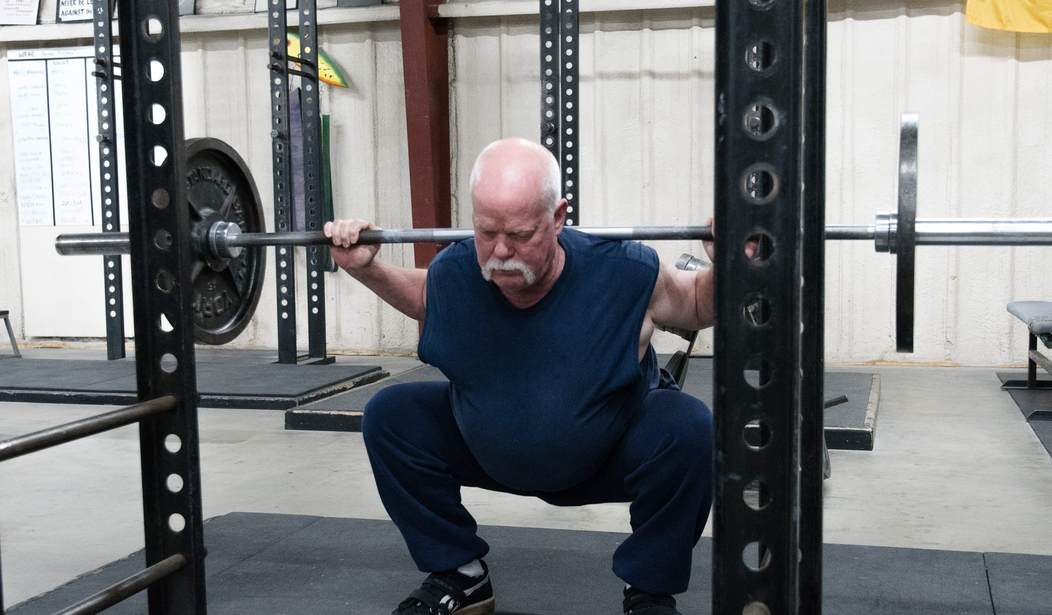I have known Scott Davison for about 20 years. A former columnist at our local newspaper, I used to read his opinions before he got fired for being on the wrong side of a local election. Prior to that, he had worked for the Strategic Air Command as a B-52 pilot, a job that provides interesting stories to this day.
A more interesting story is the tale of his journey from heart patient to lifter — his first 300-pound deadlift occurred last Friday, and I’m pleased to report that it will be just one of many more PRs.
Scott is 65, and being in the military he has been exposed to sub-optimal exercise his whole career. Being in the Air Force (the Chair Force, as it’s known in the other branches) starting in the 1980s, his PT was even more sub-maximal than it could have been. And combined with a lifetime of sub-optimal nutrition and sub-optimal genetics, he developed a degree of cardiovascular disease.
Scott’s CVD was discovered before a heart attack could occur, and on September 30, 2016, he had open-heart surgery. Two bypasses (with thankfully no heart muscle damage) and a few weeks of extremely conservative “cardiac rehab” later, he told me he was ready to take me up on that offer I’d made him every year for the past 20 — he decided that he was scared enough now to be ready to train.
I have trained heart surgery patients several times, and I know that one of the things they all are is scared — sometimes this is useful if it acts as motivation, as in Scott’s case. But scared can also interfere with the process, especially if the patient has bought into the standard medical dogma ladled out to scared people who have just had their chests cracked open: “Long slow distance wins the race.” “Don’t lift heavy weights — you’re too old for that anyway.” “You need to work your heart, not your muscles.” “You had a heart attack, not a muscle attack.”
After he was “released” to full activity by his cardiologist, we started with an extremely conservative approach to a novice strength training program on March 9. Scott had no previous history of strength training whatsoever. This was his first attempt at an organized exercise program since basic training, and certainly his first shot at intentionally getting stronger. So we started out very easy and relied on the slow accumulation of strength to do the job it always does. He trusted me on this, since there is a lot of propaganda to the contrary, but I was able to make my case convincingly — he is intelligent and I am persuasive. Strength is the basis of health, since strength training provides both strength and conditioning, especially for someone in Scott’s disadvantaged position — as he was about to discover.
The first workout was instruction on the lifts. He squatted a 22-pound bar for 3 sets of 5, pressed 22 for 3 sets of 5, and deadlifted 88 for one set of 5. That’s it — 7 total sets. His comment that day was that this was harder than anything he had done in his prescribed cardiac rehab program. Suddenly the point I’d been making was clear: a weight training workout had his heart rate and respiration rate more elevated than anything he’d done for “cardiac rehab” from heart surgery.
So, the next day he did the prowler – a loaded sled that is pushed instead of dragged. Just 22 pounds for the 60 yards for 4 reps on my inside track, but again more than he had done in rehab, and really more than he had done since basic training. He did not die, although it became a common feature of the workout to tell me that he hadn’t worked this hard, ever. This continued to progress slowly upward in load as well.
We did not know it at the time, but subsequent investigation revealed that his left lung function had been severely compromised during the surgical procedure, a complication that affects about 15% of revascularization patients. This makes breathing somewhat more difficult, but it did not affect our approach to his training.

The next workout under the bar was the same 7 sets at a slightly higher weight for the exercises, our standard approach for all novices since it works for all humans under all circumstances. The variable, especially at first, is the load, not the exercises and not the volume. The bench press was introduced later, after his sternum had healed a little more.
He continued in this pattern the rest of the year, never missing a single workout, each new PR getting reported to me as the hardest thing he’d ever done. And each time I told him that before the end of the year he’d deadlift 300, and it would be the hardest thing he’d ever done – but with 300 instead of 88. He laughed every time, and continued to do it anyway. Not everybody is as determined and disciplined as Scott, but it took a brush with death to focus his attention. I saw the commitment with which he approached his training, and I knew what would happen, and when.
Several months previously, I had told him, “You realize, of course, that you’re no longer a heart patient — you’re now a lifter.” On Christmas Day of 2017, 292 days/41 weeks after he started training, Scott deadlifted 300 pounds and squatted 205 for 3 sets of five about an inch below parallel. Hardest thing he’d ever done. He is off of all his post-surgery medication, his blood sugar treatment meds are on the way out, and he is stronger than he’s ever been — at 65 and one year after heart surgery.
And his heart is just fine, as all his doctors have assured him. He shows no signs of slowing down.









Join the conversation as a VIP Member